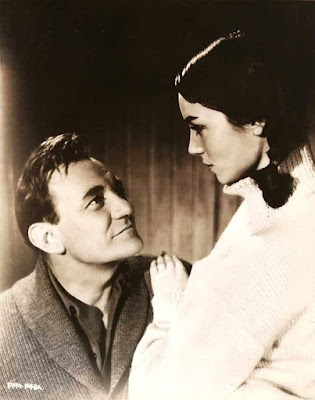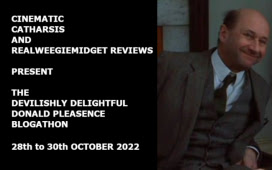O significado do nome Manuela é “Deus
está conosco”. É um nome mais comum em países de língua espanhola, por isso é
natural que o filme “Manuela”, conhecido por aqui pelo título “A Clandestina”,
comece num povoado na América do Sul.
The meaning of the name Manuela is
“God is with us”. It is a name more common in Spanish-speaking countries, so it
is only natural that the action for the film “Manuela” starts in a Spanish-speaking
pueblo in South America.
A tripulação de um navio vai à
terra firme, até um povoado próximo, porque o chefe de engenharia morreu e eles
querem que ele tenha um enterro digno em solo, não em alto-mar. Seis pessoas
estão nessa missão: o capitão James Prothero (Trevor Howard), seu subordinado
Evans (Donald Pleasence), Mario Constanza (Pedro Armendáriz) e três outros
ajudantes. Ao completarem a missão, eles decidem aproveitar a noite no povoado.
Mario é abordado por uma garota, Manuela (Elsa Martinelli), que está fugindo de
homem e quer saber se Mario consegue colocá-la a bordo do navio para a
Inglaterra, onde ela estará segura.
The crew of a ship goes ashore to a
nearby pueblo because their chief engineer died and they want him to have a
proper burial on land, not at sea. Six people are on this mission: captain
James Prothero (Trevor Howard), his subordinate Evans (Donald Pleasence), Mario
Constanza (Pedro Armendáriz) and three other helpers. When the mission is
complete, they decide to enjoy the night at the pueblo. Mario is approached by
a girl, Manuela (Elsa Martinelli), who is running away from a man and wants to
know if Mario could get her on board of the ship to England, so she can finally
be safe.
Mario termina concordando com
Manuela, não sem antes exigir sexo em troca do pequeno favor. Fica apenas
implícito que a troca foi feita, porque logo depois Manuela é levada para o
navio. O problema agora é que não há mulheres no navio, e Manuela não consegue
se disfarçar de homem. Quando o capitão descobre que ela está a bordo, Manuela
pula do navio, mas o capitão James diz à sua tripulação para resgatá-la. Então,
o calor se torna quase insuportável dentro do navio – não apenas por causa de
Manuela, mas também por causa de um problema com as caldeiras.
Mario ends up agreeing with Manuela,
not without asking for sex in exchange of this little favor. It is only implied
that the exchange was made, but the next thing you know is that Manuela is
taken on board of the ship. The problem now is that there are no women on the
ship, and Manuela can’t disguise as a boy. When the captain finds out about
her, Manuela jumps in the sea, but captain James tell his crew to rescue the
girl. Then, the heat becomes almost insufferable inside the ship – not only
because of Manuela, but also because of a problem with the furnaces.
Um grande problema com o filme –
algo que realmente me incomodou – foi que Manuela deveria ter 17 anos de idade.
Ela Martinelli tinha 22 quando o filme foi feito, e parece ainda mais madura. É
por isso que é curioso quando sua personagem diz que, aos 25 anos, as mulheres são
“velhas e gordas”. O capitão James deveria ter 43 anos e Trevor Howard, aos 44,
parece ainda mais velho. A idade de Mario nunca é mencionada, mas Pedro
Armendáriz tinha 45 quando o filme foi feito. Qualquer intimidade sugerida
entre Manuela e um dos dois é, por conta desta diferença de idade, um pouco
perturbadora.
One major problem with the movie –
something that really bothered me – is that Manuela is supposed to be
seventeen. Elsa Martinelli was 22 when the film was made, and she looks even
older. That’s why it’s so curious when her character claims that, by the time
they are 25, women are “old and fat”. Captain James was supposed to be 43, and
Trevor Howard, at 44, looks older than that. Mario’s age is never mentioned,
but Pedro Armendáriz was 45 when the film was made. Any intimacy implied
between Manuela and the two is, because of this age gap, a bit disturbing.
A trilha sonora merece destaque. As
músicas instrumentais são tocadas pela Orquestra Sinfônica de Londres, e o
diretor do departamento de música do filme é Muir Mathieson, que trabalhou em
outras películas famosas, como “Desencanto” (1945) e “Um Corpo que Cai” (1958).
Em “A Clandestina”, as músicas são perfeitas para criar uma atmosfera e
aumentar o suspense em momentos-chave.
The soundtrack is something worth
highlighting. The instrumental songs are played by the Symphonic Orchestra of
London, and the director of the music department is Muir Mathieson, who worked
in other famous movies, like “Brief Encounter” (1945) and “Vertigo” (1958). In
“Manuela”, the songs are perfect to create a mood and enhance the suspense in
key moments.
Um momento interessante acontece
quando Manuela está falando sobre seu falecido marido, que era também sócio de
seu pai: um homem brasileiro chamado... Corcovado. É praticamente impossível
encontrar aqui uma pessoa com este nome: Corcovado é o nome de um conjunto de
montanhas no Rio de Janeiro. Ao tentar destacar o que há de “exótico” na
América Latina e no Brasil, escritores e roteiristas falharam em diversas ocasiões.
A most interesting moment came when Manuela was talking about her late husband, who was also her father’s partner: a Brazilian man named... Corcovado. It’s nearly impossible to find a person with such a name here: Corcovado is actually the name of a famous mountain in Rio de Janeiro. When trying to highlight the “exotic” in Latin America and Brazil writers and screenwriters have failed again and again.
“A Clandestina” é baseado em um
livro de William Woods, que também escreveu o roteiro junto com Ivan Foxwell e
Guy Hamilton, que eram, respectivamente, produtor e diretor do filme. Hamilton
ainda iria dirigir quatro filmes de 007. Em “A Clandestina”, vale mencionar uma
excelente escolha técnica: o contra-plongée usado quando o capitão James e Mario
estão em um barquinho, e o ângulo da câmera imita o ponto de vista de James.
“Manuela” is based on a book by
William Woods, who also wrote the script alongside Ivan Foxwell and Guy
Hamilton, who were, respectively, producer and director of the film. Hamilton
would go on to direct four James Bond films. In “Manuela”, one excellent choice
of camera angle should be mentioned: the contra-plongée used when only captain
James and Mario are in a small boat, mimicking James’ point of view.
Você já percebeu que há menção ao
sexo em muitas ocasiões em “A Clandestina”. O filme dificilmente seria aprovado
pelo Código Hays nos EUA, mas na Inglaterra a censura era um pouco diferente.
Distribuidores britânicos de filmes criaram, em 1912, o British Board of Film
Censors, originando assim a autocensura dentro da indústria britânica do
cinema. Os filmes aprovados pela junta recebiam um certificado para ser exibido
no início, algo que pode ser visto em “A Clandestina”:
You have already seen that sex is
implied in several moments in “Manuela”. The film would hardly be approved by
the Hays Code in the US, but in England censorship was a bit different. British
film distributors had created, in 1912, the British Board of Film Censors,
originating with this the self-regulation within the British film industry. The
films approved by the board received a certificate to be exhibited in the
beginning, something that we can see in “Manuela”:
“A Clandestina” não é um filme
perfeito nem uma joia escondida. É escondido, sem dúvidas, e é divertido. Você
não está perdendo muito se não viu o filme, mas se decidir vê-lo, com certeza
terá 90 minutos agradáveis.
“Manuela” isn’t a perfect film nor a
hidden gem. It’s hidden, no doubt about it, and it’s entertaining. You’re not
missing much if you haven’t watched it, but if you do decide to watch the movie,
you’ll certainly spend pleasant 90 minutes.
This is my contribution to the Devilishly
Delightful Donald Pleasence blogathon, hosted by Gill and Barry at
RealWeegieMidget Reviews and Cinematic Catharsis.






























